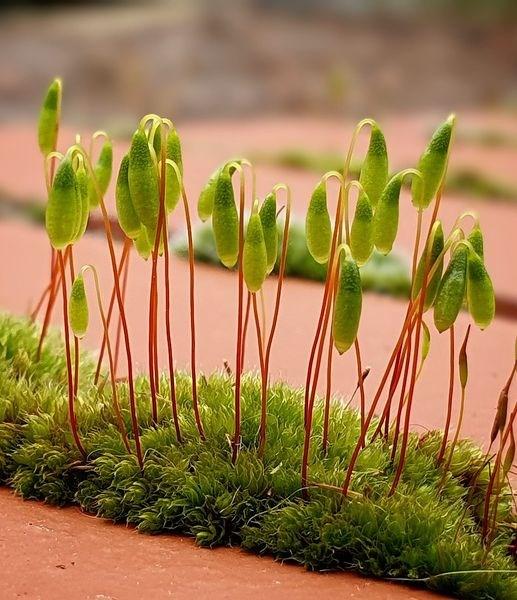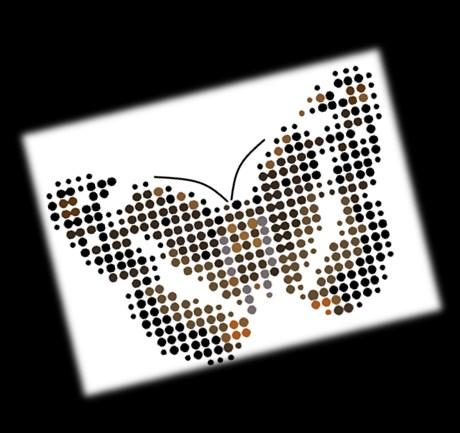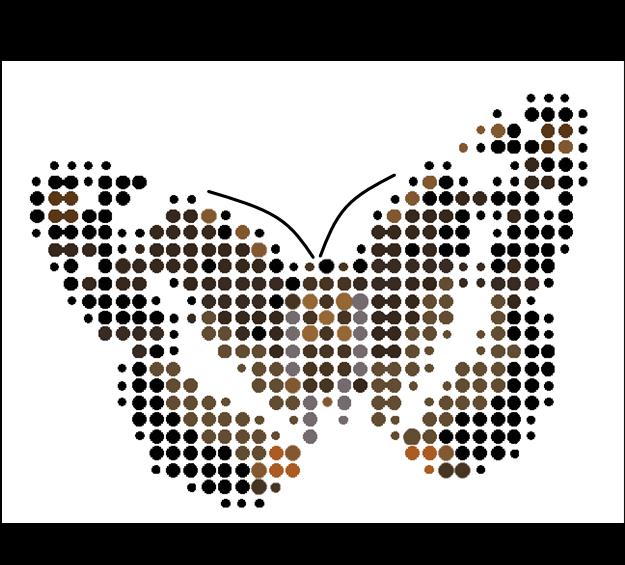From the editor
Hi everyone,
Hope everyone is doing well. Firstly, I must apologise for the lateness of this edition going out. Unfortunately, things have been rather busy for me of late and this brings me to another apology. It is with great sadness that this will be my last edition as editor of the magazine. Due to several personal issues, time has become a precious thing which I am not getting much of and some things I have to let go and it is with much reluctance, being the editor is one of those things. However, fear not, Emma Aldous, Website designer for SBIS has stepped into the role and I’m sure Emma will do a cracking job.

I won’t be disappearing completely, I will still be staying on the council for the social media pages of the Society, so will still be around. I would like to thank everyone for your support during my term as editor, from members and council too. It really has meant a lot and I totally appreciate it. I would also like to wish Emma all the best in the role and I’m sure you all do too and will keep her supplied with plenty of content for future editions of the White Admiral.
Many thanks to you all.
All the best.
White Admiral 114 2
Hawk Editor Hawk Honey 1 Felix Cottage Athelington Rd, Horham, IP21 5EG whiteadmiralnewsletter@gmail.com
The day started at 9 am on 18th August at Orford Quay, a little blustery but no rain fortunately. Just six eager individuals and 2 wardens from the RSPB.
Sadly, a dead Dolphin was seen from the quayside a very unusual sight, and one of the group went to investigate. We were soon clambering into the small boat and motoring along the water, passing the historic Atomic Weapons Research Establishment, and after a short while, mooring onto the small landing jetty on Havergate Island. Suffolk’s only island.
It is a marshy nature reserve, situated at the confluence of the River Ore and Butley River, and is 3.2 km long and 0.80 km across at its widest point, covering 267 acres. It is well known for its Spoonbills, Terns and Avocets and large numbers of wading birds and ducks in the winter.
Prior to the war the island was used for summer grazing, but without human intervention salt water flooded parts of the island making it unsuitable for agricultural use. In 1947 pied avocets were found on the island, the first time since they had become extinct in the country over 100 years before. The RSPB then purchased the land in 1948 and have since managed it for the benefit of birds and the environment.
Facilities include a compost toilet, and 5 hides, and a viewing screen overlooking the saline lagoons.
The group all had different interests, so with the island all to ourselves, we all went our separate ways to explore and see what wildlife the island had to offer. The wardens have a little hut on the island and the lure of coffee soon tempted me to make this an early port of call, a treat, as hot drinks would not normally be provided to visitors on the island!
I followed one of the trails to the hides and soon started to add to my list of species as the hides appeared to be little used and the spiders, enjoying the tranquility, had made numerous webs, in and around the Pamela Pope
White Admiral 114 3
hides. Neoscona adianta is a predominantly coastal species, with very few inland records.
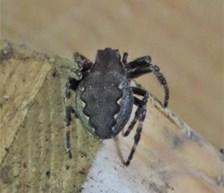
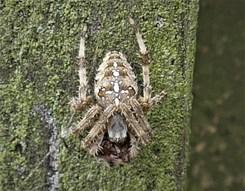

From the hide across to the mainland one could see a rather misty but beautiful view of Orford Castle with the Spoonbills feeding in front, 14 were counted in all and a Common Ringed-plover Charadrius hiaticula too.
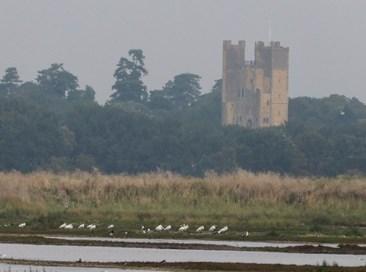

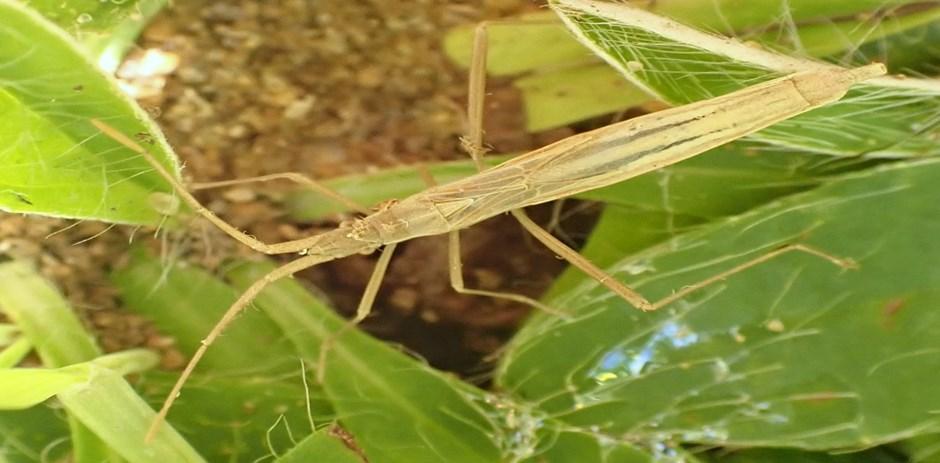
Left: Chorosoma shillingi.
Right: Neocrepidodera impressa.
Chorosoma shillingi (14-16mm) was one of the Rhopalid bugs found. Usually found in sand dunes and long grasses, it is a master of camouflage.

White Admiral 114 4
From Left to right: Walnut Orb Weaver Nucteneaumbratical,Garden spider Araneusdiadematusand Neosconaadianta.
Common Ringed-plover Charadriushiaticula
Neocrepidodera impressa – Family Chrysomelidae (4.5-5.0mm) is quite scarce being classed as Notable A. It is found in salt-marsh habitats on sea lavender at only a few Suffolk coastal sites according to NBN. Identity confirmed from the aedeagus.

Andrena pillipes – The Black Mining Bee was a rare find, only 4th record for Suffolk. This is an almost entirely black species which seems to be predominantly coastal. The summer generation tend to feed on bramble and summer umbellifers such as Hogweed.

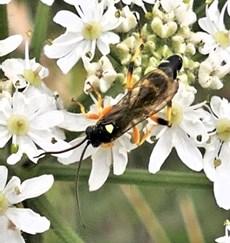
Ichneumon sarcitorius (10-12mm) often found on umbellifers.
Host often the Turnip Moth larvae Agrotis segetum

Ancistrocerus sp is a solitary wasp species with a narrow body. They prey on the larvae of moths and beetles.
The Lesser Marsh Grasshopper, Chorthippus albomarginatus (1223mm) is found mainly in south and central Britain. Similar to the meadow grasshopper but less brightly coloured and with side keels on the pronotum almost parallel.
White Admiral 114 5

The day went very quickly and just as we were thinking about walking back to the departure point, I saw something red scurrying in the sand. It was moving so quickly and although I managed to take a few photos I thought it must be a beetle. On uploading my photos to the computer later, (and with my glasses on!) I realized that what I had seen was a nationally scarce Large Velvet Ant, Mutilla europaea. (9-14mm).


It is a species of parasitoid wasp inhabiting coastal dunes and chalk grasslands, mainly in Southern England.
Common host is the Bumblebee, Bombus sp.
Boating back past the Atomic Weapons Research Establishment and an old Thames Barge I think I can say we all had an excellent day. Thank you to Hawk Honey for arranging!
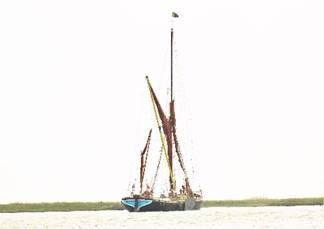

White Admiral 114 6
Large Velvet Ant Mutillaeuropea
Lesser Marsh Grasshopper, Chorthippusalbomarginatus
Species list
Diptera
Rose gall midge
Parasitic Fly
Hoverfly
Lauxaniidae
Barred Snout - Soldier Fly
Snail-killing Fly
Hoverfly
Hoverfly
Arachnids
Garden Spider
Bridge Orbweb Spider
Spider
Walnut Orbweb Spider
Long-jawed orbweb spider
Hymenoptera
Ichneumon wasp
Solitary Wasp
Pea gall
Robin's pincushion gall
Large Velvet Ant
Galls on Picris echioides
German Wasp
Buff-tailed Bumblebee
Red-tailed Bumblebee
Brown-footed Leafcutter Bee
Black Mining Bee
Brown-footed Leafcutter bee
Lepidoptera
Dasineura rosae
Eriothrix rufomaculatus
Eristalis tenax (m)
Lauxaniid sp
Nemotelus uliginosus
Sciomyzidae sp
Sphaerophoria Scripta (m)
Sphaerophoria sp (f)
Araneus diadematus
Larinioides sclopetarius
Neoscona adianta
Nuctena umbratical
Tetragnatha extensis
Amblyteles armatorius
Ancistrocerus sp
Diplolepis eglanteriae/nervosa
Diplolepis rosae
Mutilla europaea
Phanacis caulicola
Vespula germanica
Bombus terrestris
Bombus lapidarius
Megachile versicolor
Andrena pilipes
Megachile versicolor
Peacock Butterfly Aglais io
Yellow Shell Moth
Small Heath Butterfly
Ground Lackey Caterpillar
White-speckled Bagworm
Camptogramma bilineata
Coenonympha pamphilus
Malacosoma castrensis
Narycia duplicella larvae
Small White Butterfly Pieris rapae
Coleoptera
Ground beetle
Leaf beetle
7-spot ladybird
11 Spot Ladybird
Leaf beetle
Leaf beetle
Amara aenea
Chrysolina banksi
Coccinella septempunctata
Coccinella undecipunctata
Longitarsus parvulus
Neocrepidodera impressa
Ground beetle Paradromius linearis
Ladybird Rhyzobius litura
Darkling beetle
24-spot ladybird
16-spot ladybird
Orthoptera
Grey Bush-cricket
Lesser Marsh Grasshopper
Odonata
Common Blue Damselfly
Scaphidema metallicum
Subcoccinella vigintiquattuorpunctata
Tytthaspis sedecimpunctata
Platycleis albopunctata
Chorthippus albomarginatus
Enallagma cyathigerum
White Admiral 114 7
Coleoptera records from Martin Collier
Family Species Comments
Anthicidae Anthicus antherinus
Anthicidae Cordicollis instabilis
Anthicidae Cyclodinus constrictus
Apionidae Pseudaplemonus limonii
Carabidae Amara similata
Carabidae Bembidion normannum
Carabidae Paradromius linearis
Carabidae Philorhizus notatus
Chrysomelidae Neocrepidodera ferruginea
Coccinellidae Rhyzobius litura
Coccinellidae Subcoccinella 24-punctata
Coccinellidae Tytthaspis 16-punctata
Cryptophagidae Atomaria testacea
Curculionidae Ceutorhynchus contractus
Curculionidae Cosmobaris scolopacea 1st county record
Curculionidae Lixus scabricollis
Curculionidae Mecinus pascuorum
Curculionidae Pselactus spadix
Hydraenidae Ochthebius auriculatus
Hydrophilidae Enochrus bicolor
Latridiidae Cartodere bifasciata
Latridiidae Corticaria crenulata
Latridiidae Corticaria impressa
Latridiidae Corticarina curta
Phalacridae Olibrus aeneus
Staphylinidae Aleochara curtula
Staphylinidae Aleochara lanuginosa
Staphylinidae Astenus lyonessius
Staphylinidae Bisnius parcus
Staphylinidae Brachygluta helferi
Staphylinidae Cafius xantholoma
Staphylinidae Drusilla canliculata
Staphylinidae Metopsia clypeata
Staphylinidae Philonthus succicola
Staphylinidae Sepedophilus nigripennis
Staphylinidae Stenus clavicornis
Staphylinidae Stenus ossium
Staphylinidae Xantholinus gallicus
Tenebrionidae Lagria hirta
White Admiral 114 8
Bird Species
Barn Swallow (White-bellied)
Black-bellied Plover
Black-headed Gull
Black-tailed Godwit
Hirundo rustica
Pluvialis squatarola
Chroicocephalus ridibundus
Limosa limosa
Canada Goose Branta canadensis
Carrion Crow Corvus corone
Common Greenshank
Common Redshank
Common Ringed Plover
Common Sandpiper
Common Shelduck
Common Tern (hirundo/tibetana)
Common Wood-Pigeon (White-necked)
Tringa nebularia
Tringa totanus
Charadrius hiaticula
Actitis hypoleucos
Tadorna tadorna
Sterna hirundo
Columba palumbus
Dunlin Calidris alpina
Eurasian Curlew - 15
Eurasian Kestrel (Eurasian)
Eurasian Linnet - 10
Eurasian Marsh-Harrier - 2
Eurasian Oystercatcher (Western)
Eurasian Spoonbill - 14
European Starling
Gadwall (Common) -5
Garden Warbler
Grey Heron (Gray)
Greylag Goose (European)
Great Black-backed Gull
Great Cormorant
Green-winged teal (Eurasian)
Herring Gull (European)
Lesser Black-backed Gull
Little Egret (Western)
Little Tern - 5
Mallard
Numenius arquata
Falco tinnunculus
Linaria cannabina
Circus aeruginosus
Haematopus ostralegus
Platalea leucorodia
Sturnus vulgaris
Mareca strepera
Sylvia borin
Ardea cinerea
Anser anser
Larus marinus
Phalacrocorax carbo
Anas crecca
Larus argentatus
Larus fuscus
Egretta garzetta
Sternula albifrons
Anas platyrhynchos
White Admiral 114 9
Meadow Pippit
Mute Swan
Pied Avocet
Red Knot - 10
Ruddy Turnstone
Ruff
Sanderling
Sandwich Tern (Eurasian)
Stock Dove
White Wagtail (British)
Yellow-legged Gull (michahellis)
Anthus pratensis
Cygnus olor
Recurvirostra avosetta
Calidris canutus
Arenaria interpres
Calidris pugnax
Calidris alba
Thalasseus sandvicensis
Columba oenas
Motacilla alba
Larus michahellis
Total Species recorded 125
Editor’s note:
Thank you Pam and all those who submitted their records via the SBIS website. As you can see 124 species were recorded and I’m sure there was potential for much more. Unfortunately, I will no longer be able to organise these field trips any more. However, do you feel you could? Then get in touch and let us know. Everyone who has come along has enjoyed the trips, it just needs someone who
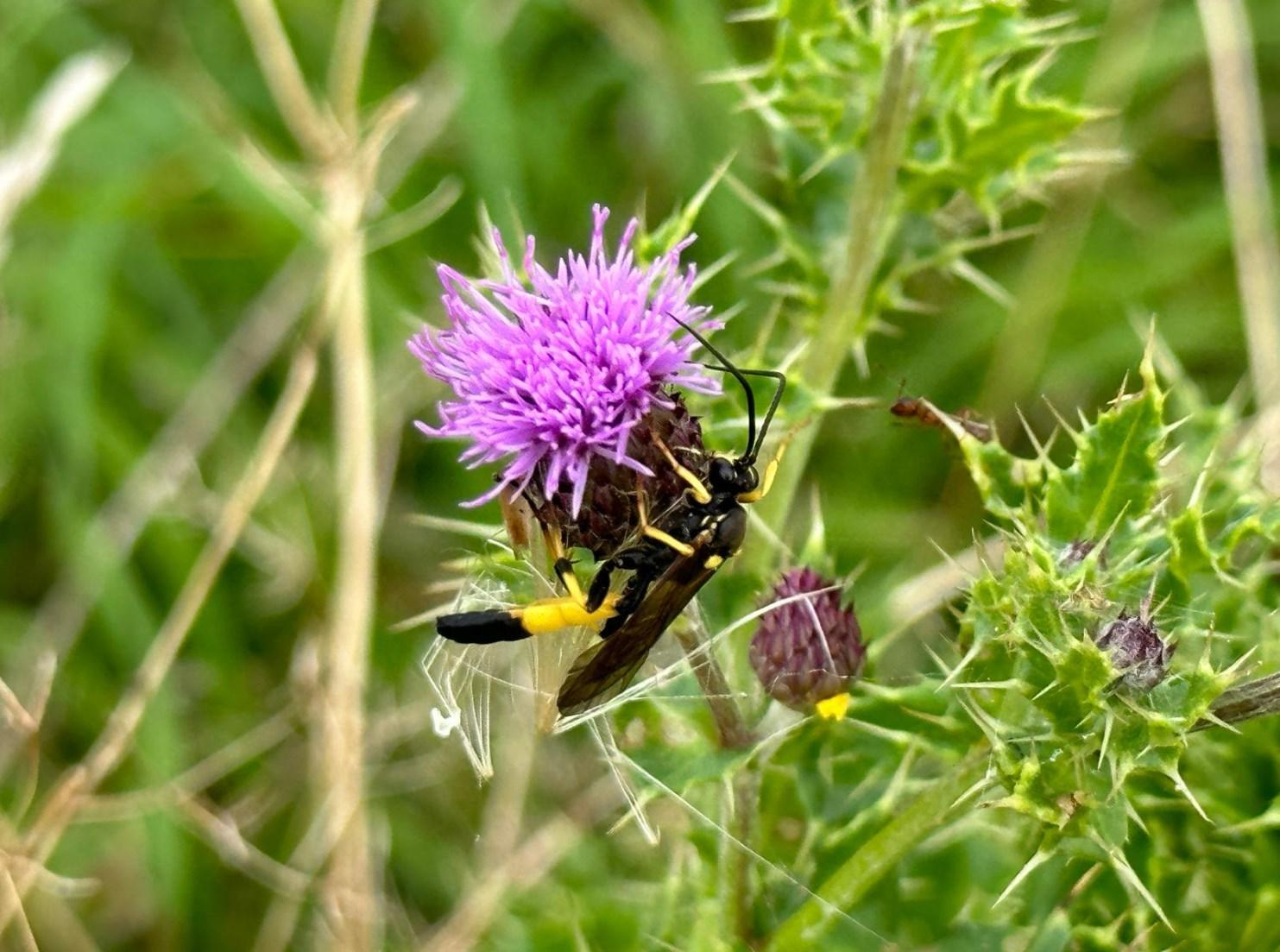
White Admiral 114 10
Ichneumon Amblytelesarmatorius.Photo: H Honey
At home, one of our veteran oak trees is showing signs that it is coming to the end of its life. Although it is one of the ‘smaller’ oaks here, it is still a few hundred years old.
In Winter, the many dead limbs are silhouetted against the sky and in summer they become obscured by new growth from the living parts.
Due to historic pollarding, where branches were, holes are formed that connect to the hollow core.

I have read that an oak tree supports thousands of species of wildlife including lichens, fungi, mosses, and invertebrates, 300 of which are solely reliant on oaks, and this tree is no exception.
Barn owls have nested in the largest hole ever since I moved here 15 years ago and recently a pair of Kestrels took over a hole close to this from Stock doves, and before that there were squirrels living there.
Great spotted woodpecker, and Green woodpecker also nest in the upper branches and their old nest holes allow Great tit and Blue tit to make their home.
White Admiral 114 11
Trevor Goodfellow
This year our frequent visitors: a pair of Egyptian geese, shunning the nest box I erected nearby for their use, have decided to nest in the Barn owl’s hole!
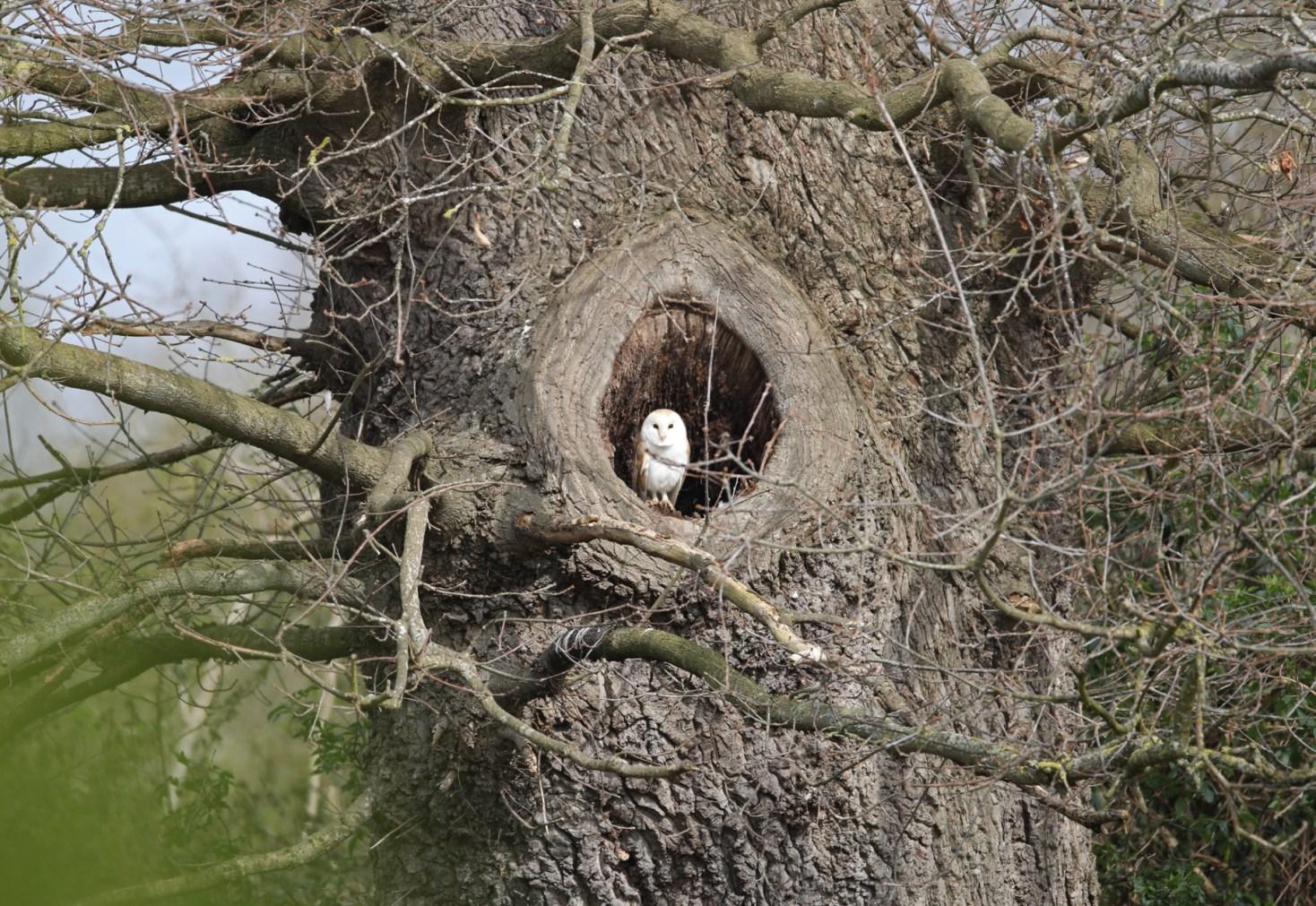
It will be interesting to see if the poor Barn owls will tolerate another lodger, and a ‘Johnny foreigner’ at that.
Could it be possible that the geese nest at the foot of the hole and the owls in a chamber halfway down? As Barn owl nests are protected, I am not qualified to investigate but hopefully something good comes from this situation. I wonder how the goslings will extricate themselves.
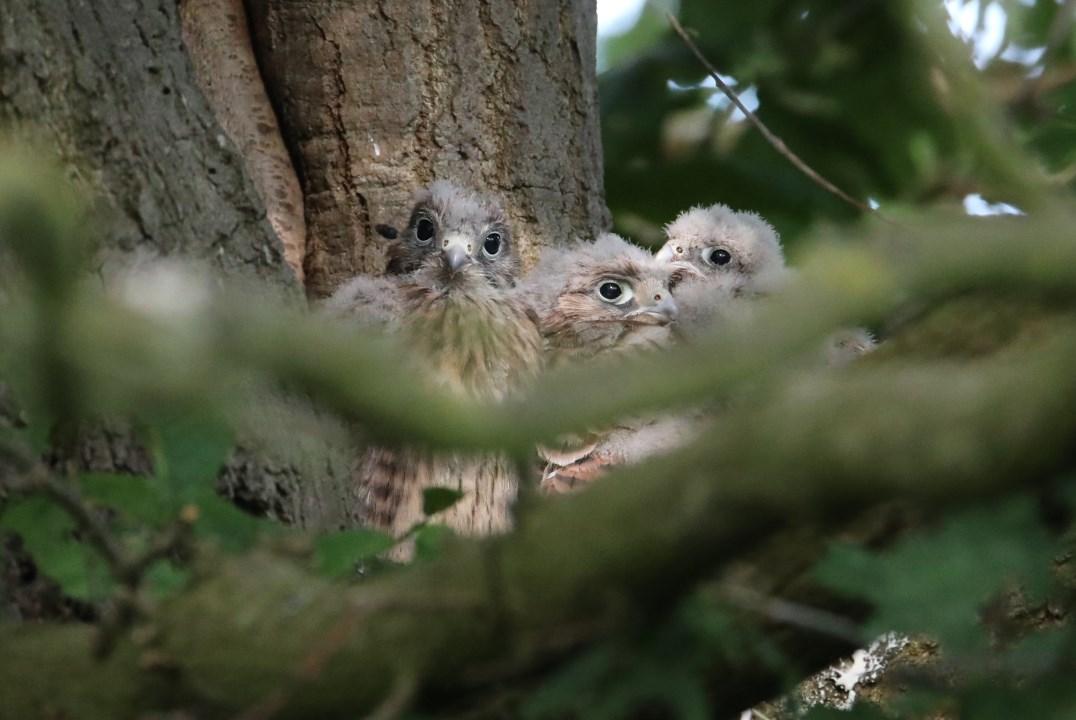
White Admiral 114 12
Kestrel chicks
Alfred Waller
As I mentioned in my previous reminiscence, I was encouraged by my grandfather, a noted amateur entomologist in Suffolk, to take an interest in natural history and in particular in entomology. My first acquisition was a butterfly/moth net. I was not particularly interested in daubing a mixture of rum and treacle on tree trunks in our garden to attract moths rather than frogs and toads but I had noted that night flying moths were attracted by light.
At the top of our road there was a red GPO telephone box and I had noticed that it was often full of moths which had flown up its glass sides, in through its ventilator shaft at the top of it to the electric light bulb fixed inside on the ceiling. The moths then found a suitable resting place somewhere away from the direct light. It became my first moth trap at no cost to me provided I was there at dawn. Indeed, there were also financial incentives included because the previous day’s customers had often forgotten to press the ‘return of money button’. In fact, I managed to collect a very rare moth that was new to Suffolk and the Eastern Counties which I had to report to the Recorder at the London Natural History Museum – he with that funny name (see previous Reminiscence).
When I was 18 and just about to go into the Army for my National Service, my family gave me a new -fangled mercury vapour light bulb which a local electrician had made into a moth trap. It was much more efficient than the telephone box and it enabled me to set it up anywhere in the rectory garden and I did not have to get up so early. The light beams were so
White Admiral 114 13
powerful that it would attract moths from all over the garden. I have mentioned above that the method my grandfather used attracted many toads and frogs for a feast of intoxicated moths. This time I had a problem with bats which were attracted by the cloud of moths flying to the trap. The only deterrent I found useful was a horse whip which generated a high -pitched sound the bats didn’t like. And no, because they were such agile flyers they always avoided the whip lash. A bigger problem was hornets. I was unaware that they were also night flyers and attracted to bright lights. Whenever I tried to catch them in my moth net hovering over the light, invariably they homed in on me with painful consequences!
AlfredWaller
I was out walking at North Warren towards the end of July last year, when I suddenly saw a flash of yellow which landed on the ground. When I looked closer, I saw a lovely female pantaloon bee Dasypoda hirtipes. She uses the long hairs on her hind legs to carry pollen and brushes away the sand as she digs out her nest.
With the bright yellow pollen baskets on her hind legs, she was pretty unmistakeable, and with a field of yellow flowers close by it was easy to see where she had been. As I stood there quietly it was fascinating to watch this solitary mining bee in front of me, just a few inches awayas she went about her daily life during her flight period. This is one of the wonders of nature!
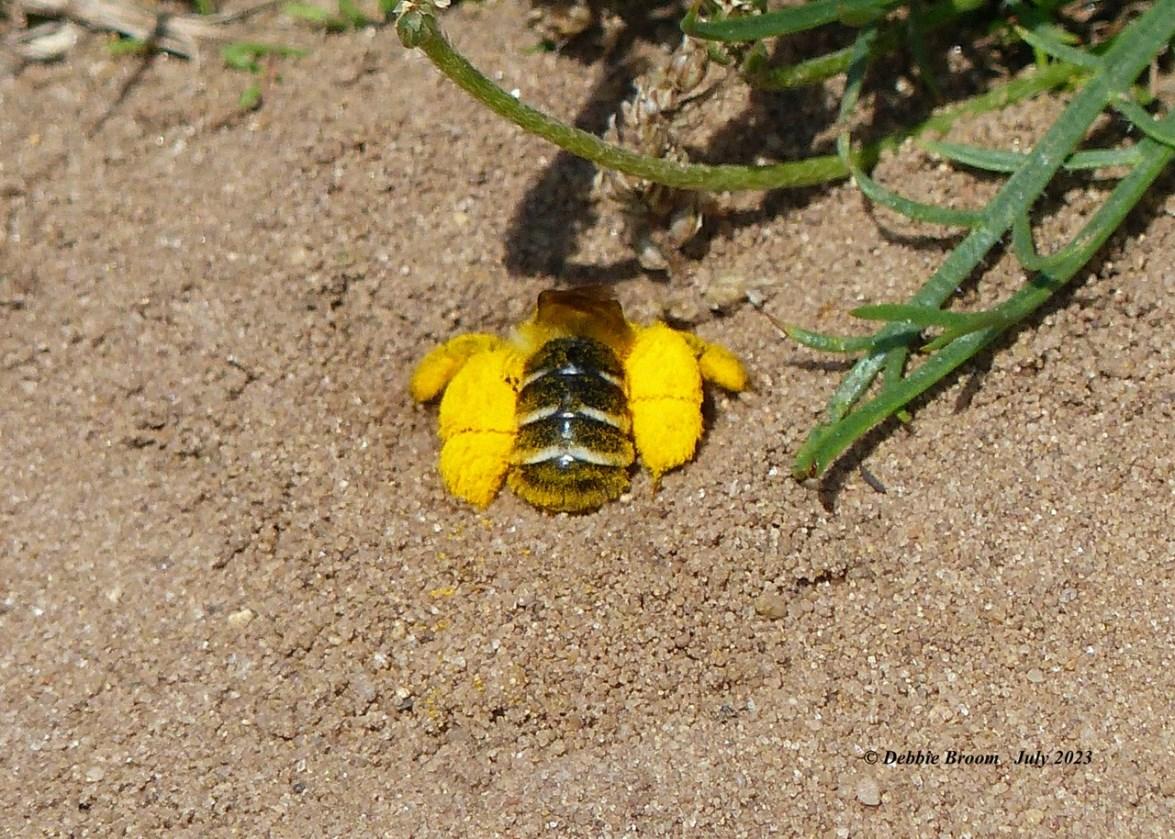
14
This area is such a fantastic place for a walk. North Warren is important as a SSSI and such a special place, home to an abundance of species of animals, birds, plants, butterflies, moths, fungi etc. With its rich biodiversity and differing habitats, it has given countless numbers of people immense pleasure and the opportunity to see so many different species, since becoming a reserve in 1939 more than 80 years ago.
We need to do all we can to ensure that this remarkable place is protected and continues to support the mosaic of wildlife that depends upon it and calls it home.
One early evening in September when we returned home, what should we see but a young hedgehog on the gravel path dividing our front garden, barely ten yards in front. We were simply transfixed by this beautiful ‘spiny’ creature. It was around 15-18 cm long so possibly not long out of the nest. Since it was foraging on its own, it was at least a couple of months old. Hedgehogs are weaned when they are a month old, subsequentlyforagingwith motherforanothermonth.
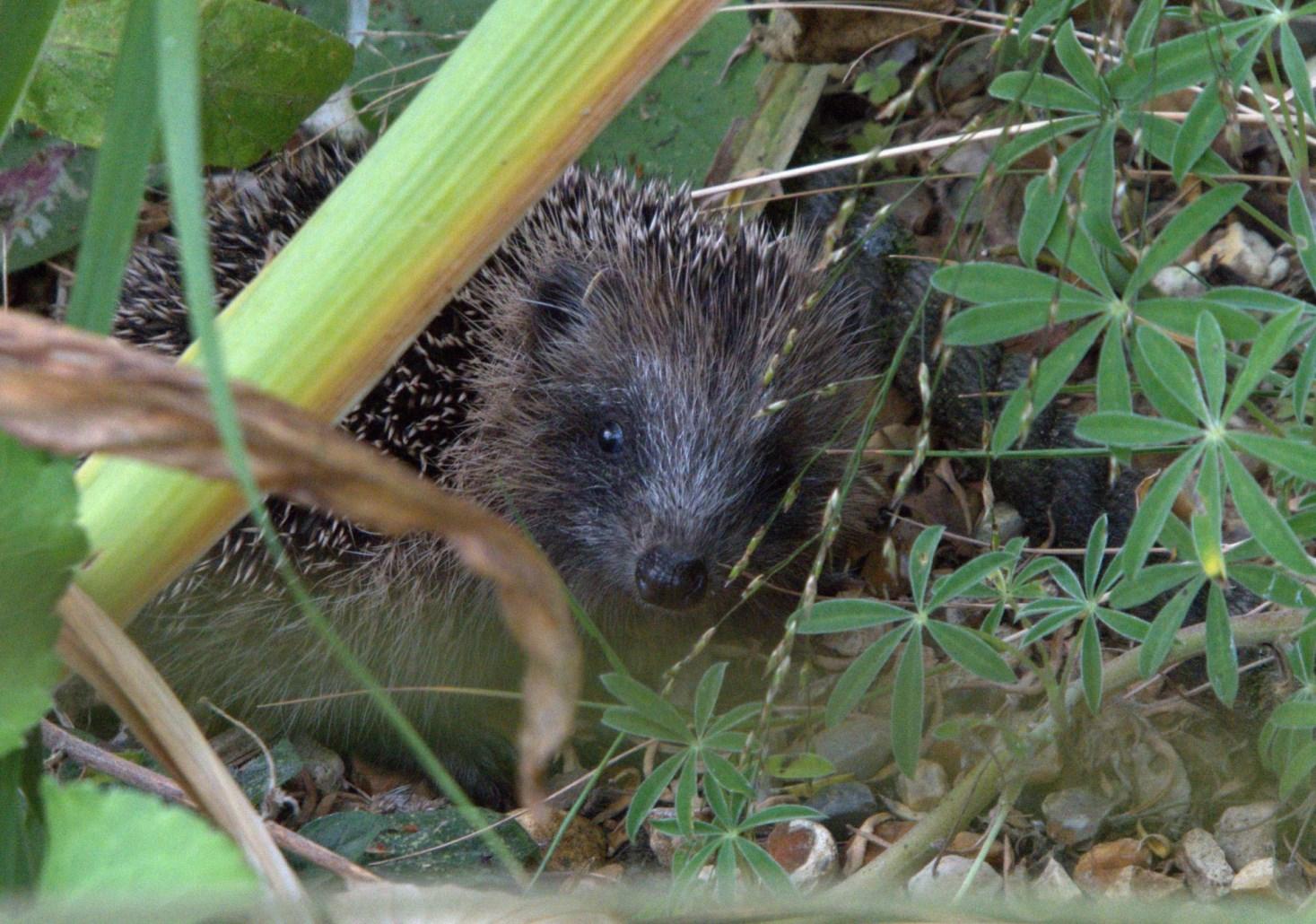
White Admiral 114 15
Unaware of us, it took almost five minutes going across the path snuffling as it made its way towards our well-established Beth Chatto style gravel garden (providing excellent cover) on the left. We waited until it had made its way past the lupin tree and under the cover provided by Miscanthus and Eryngium. Perhaps this was our chance. So, gently and quietly, keeping a wide berth, we made our way past where it had gone in. But as we glanced back, we saw that it was motionless – it had heard us! Apart from a strong sense of smell, hedgehogs also have excellent hearing.
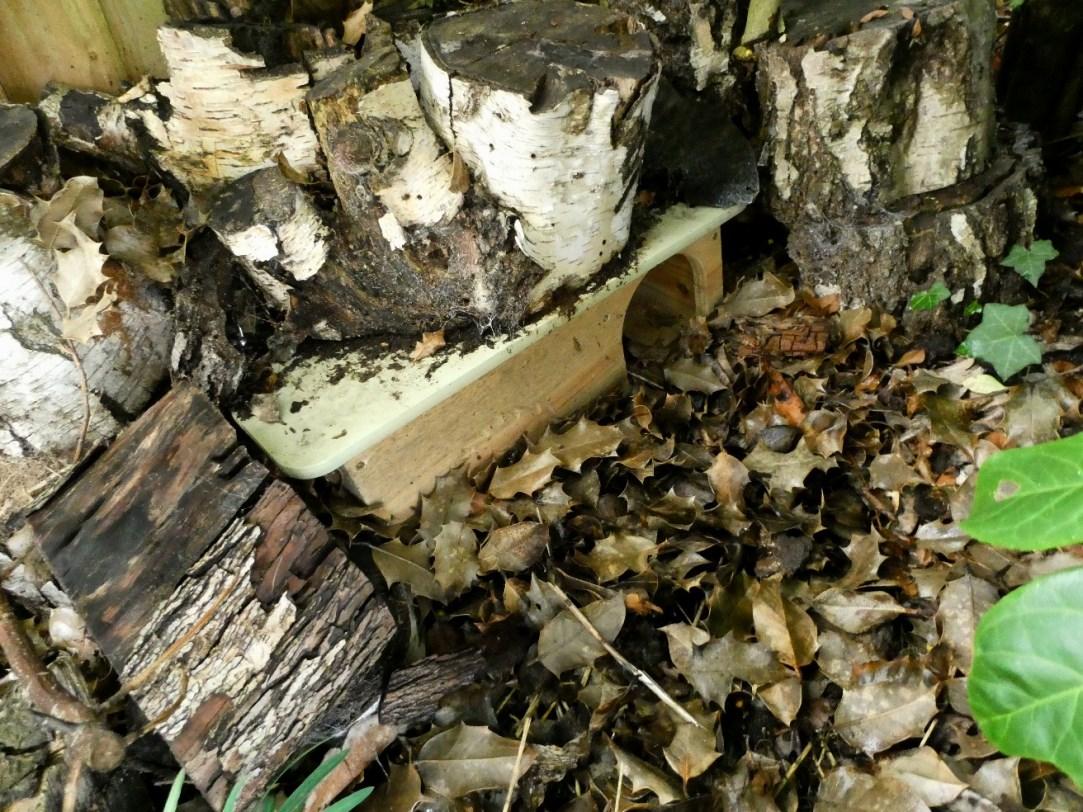
We thought it best to go in and leave it free to forage. However, out of curiosity, a few minutes later, I decided to creep out but this time armed with a camera. The hedgehog had moved a little forward and although nearly four yards away, it noticed me and looked at me somewhat cautiously (see photo 1). I wasn’t out that long, but elated that the hedgehog had found our ‘wildlife-friendly’ garden. However, this sighting was somewhat of a culmination. Back in April we had noticed some signs of nocturnal hedgehog activity - cylindrical and firmly compressed 3-5 cm long dark droppings, studded with shiny insect bits. And in June, we had witnessed an adult hedgehog a number of times at dusk, in the back garden. In August, we also spied an adult entering the hedgehog house in the front. So, what a year so far!
Top: Luxury hedgehog house.
Right: Hedgehog highway.
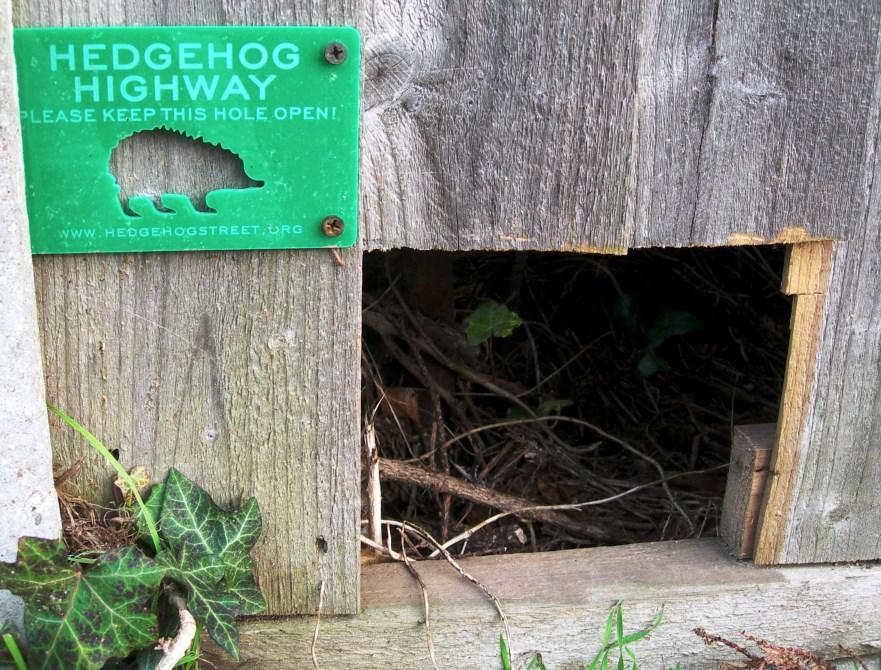
White Admiral 114 16
With the help of East Bergholt Futures and the Dedham Vale AONB teams, modifications made in the previous year had more than paid off. In June 22, we were donated two tunnel-shaped hedgehog boxes which we installed in the back garden. Then, as part of East Bergholt’s Hedgehog Highway, Will kindly cut out two holes through the fences, connecting our front and back gardens. In August, we were given a ‘luxury’ hedgehog box (see photo 2) which we placed in a secluded corner in the front garden for itinerant hedgehogs. In November, laudable Emma Black (Dedham Vale Projects’ Officer) arranged for Phil to cut out more holes (see photo 3) in our back garden connecting us to seven other gardens – a hedgehog ‘super-connectivity’ indeed! So, with thanks to those who care, these shy and meek garden visitors will, hopefully, treat our garden as a safe haven for years to come. Is your garden hedgehog-friendly and well-connected?
SNS Invertebrate Recording meeting
Halesworth Millennium Green invertebrate survey
20th July 10am—4pm
Buns and soft drinks provided.
Situated in the centre of Halesworth, the Millennium Green is celebrating 25 years in public ownership and to mark this occasion they are keen to update their invertebrate records for the site.
This mixed habitat comprises grassland, ponds, dykes, rivers and fens, mature trees and a smaller heathy area and SNS Recorders and other specialists should find much to interest them here.
Visit: https://millenniumgreen.halesworth.net/
Toexpress an interest in attending, or forfurtherinformation contact
Nicky Rowbottom
nicky.rowbottom@btinternet.com
White Admiral 114 17
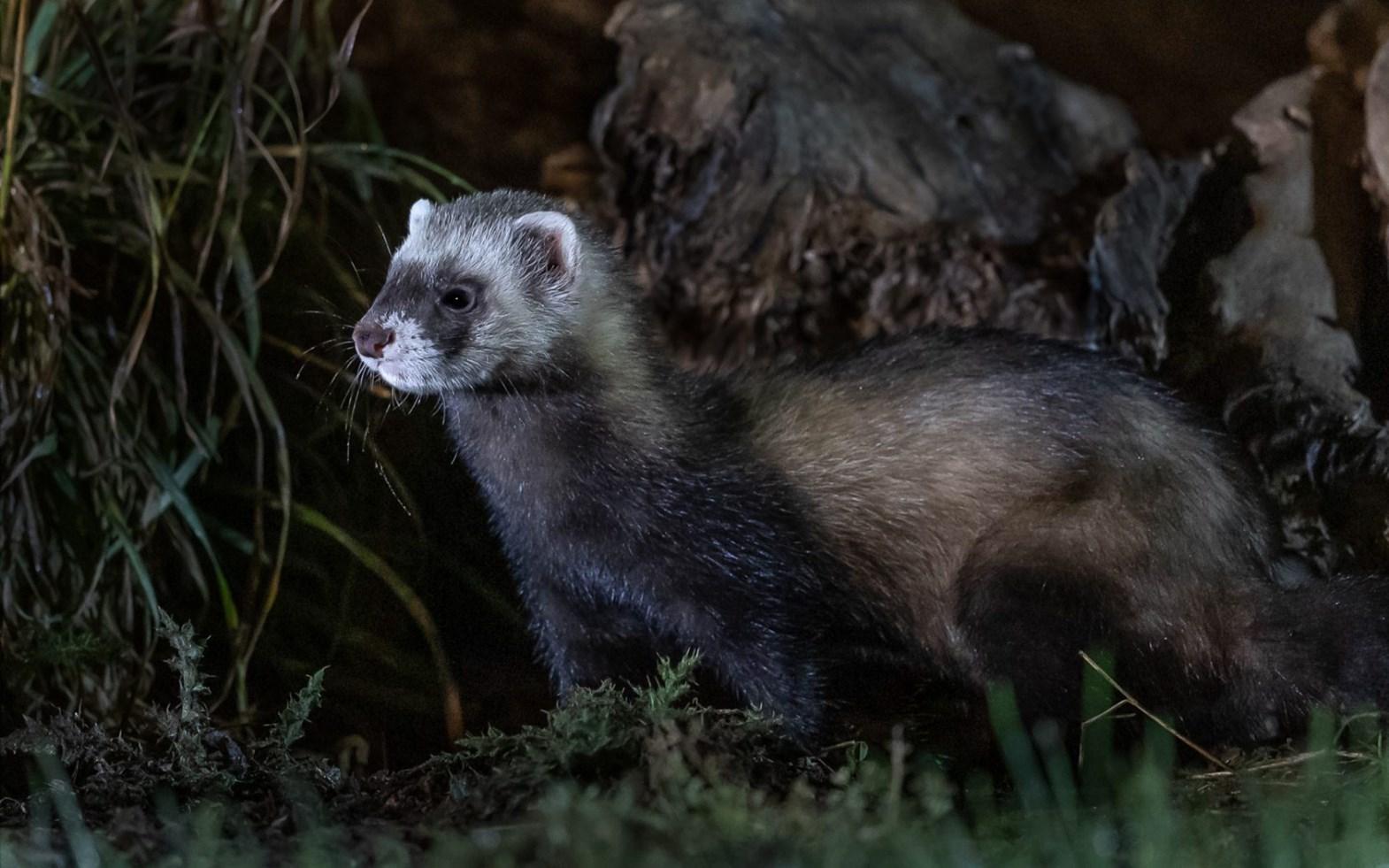
Every ten years the Vincent Wildlife Trust (VWT) conducts a National Polecat Survey to assess the current distribution of Polecats (Mustela putorius). The latest survey for 2024- 2025 is appealing for members of the public to assist as ‘community scientists’. SBIS has been active in monitoring Polecats even since the last National Survey, and as you can see from the map below, we have a good record of sightings: If you can assist with this current survey it would be greatly appreciated.
Some Background Information on the Polecat
It is very unlikely you will see a live Polecat in the wild. They are not only nocturnal but also very secretive and are probably the least known of our UK mustelids. Most observations will be from Road Traffic Accidents (RTA’s) as the Polecat forages for fresh killed carrion at night. Polecats were once a common and widespread native British carnivore, but by 1915 were eradicated from most of their former range, remaining only in small strongholds in mid-Wales and the English borders. The reason for the decline was primarily due to persecution by both gamekeepers and the general public.
White Admiral 114 18
The Polecat appears to have been the most hated animal in the past due to the defensive stink emitted from its anal glands and its liking for poultry/livestock. As you can see from the map, as the Polecat has moved eastwards.
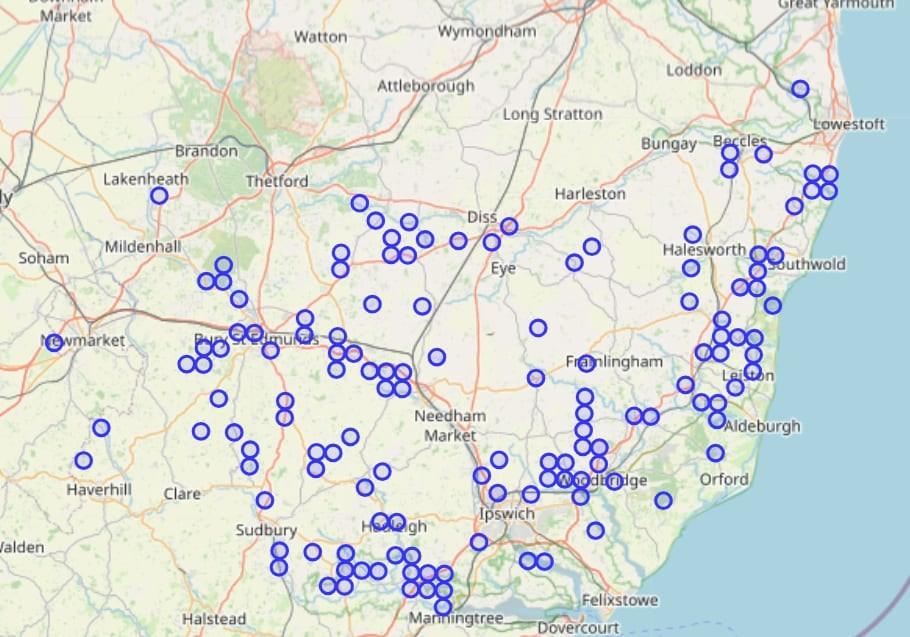

There is a strong concentration of observations in Suffolk as the North Sea provides a barrier to further movement. Polecats have an innate ability for predating on rabbits which in the past led to them being domesticated as ferrets for hunting. This subsequently led to some escaping into the wild and becoming feral and breeding with wild polecats to form the hybrid ‘polecatferret’ which can provide a major challenge when trying to differentiate them from ‘true polecats’.
White Admiral 114 19
How to Identify a Polecat
Some key identifying features:
• Mask-like pattern of dark and light fur on its face. The dark fur should be clearly distinguished, can be extensive and should extend to the nose.
• Dark coloured fur all over the body.
• Lighter. buff undercoat which can show through the darker fur. See the chart below which will assist in identifying polecats, ferrets and hybrids.
See the chart below which will assist in identifying polecats, ferrets and hybrids.
Access to the Survey
The data for Suffolk can be continued to be collected by the specific SBIS Polecat website which will then be forwarded to the VWT. SBIS website. In addition to the established phenotype analysis in assessing the observations, the VWT will be collecting some samples for this survey to aid with genetic and dietary analysis. This will involve the collection of hair and whiskers. If you feel you are also willing/able to assist with this aspect of the surveyplease let us know and we will send additional instructions As mentioned above, most of the observations will be from RTA’s so please be extremely careful when collecting your data.
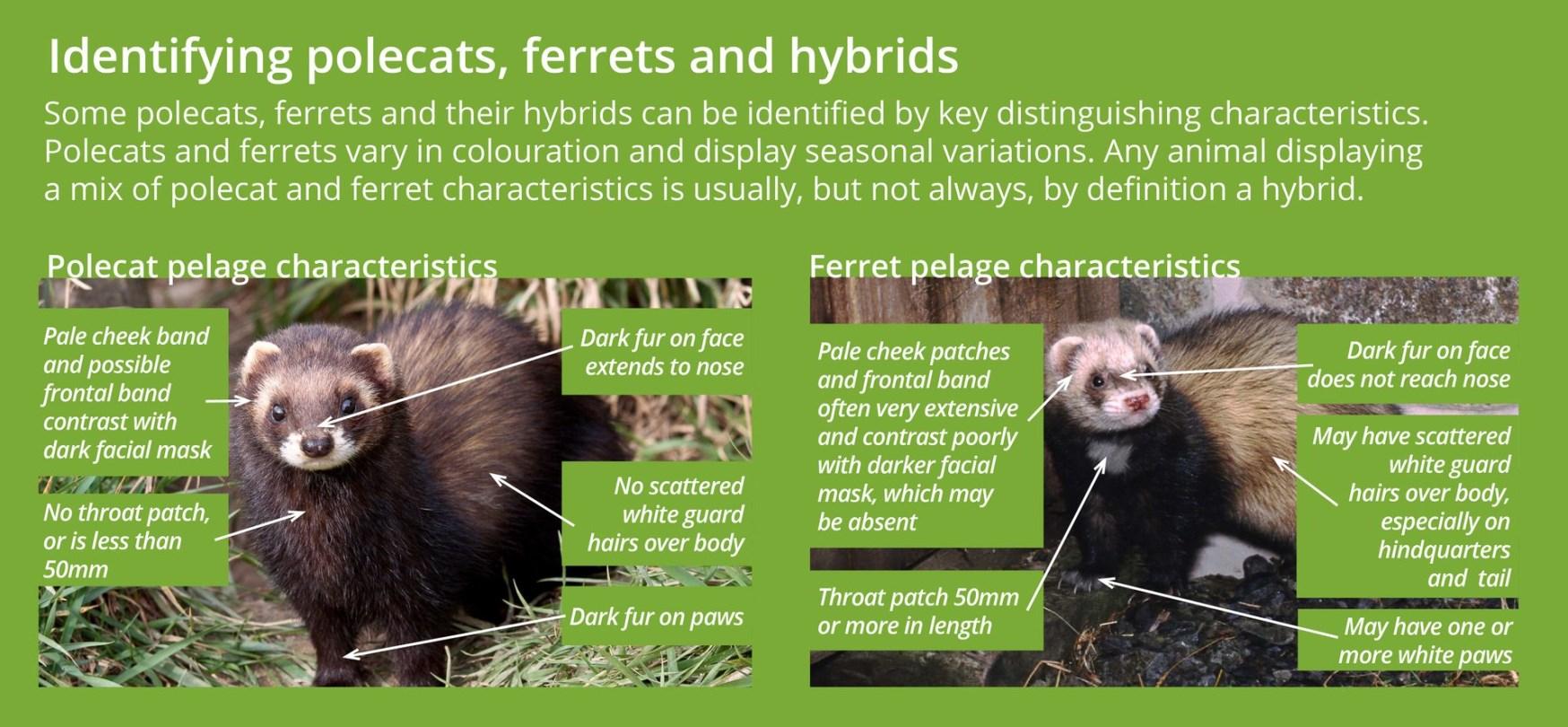
If you have any questions or need further clarification, please do not hesitate to contact me at hancockmjf@aol.com or enquiries@vwt.org.uk
White Admiral 114 20
Trevor Goodfellow
After an interesting year in 2023 finding some species of moth new to me, and frustrating weather upsetting my Dingy Skipper (Erynnis tages) survey in King’s Forest last spring, I now look forward with hope for 2024.
The local juvenile White-tailed Eagle (Haliaeetus albicilla) sightings kept coming during January and February, then a second bird originating in Sussex joined it.
I took some close-up shots of the Dutch bird (WN88) on Christmas morning during a routine visit to SWT Micklemere, so that was a nice surprise. Further opportunities arose over the next two months allowing me to take some varied photos of them together, in flight, and perching. I was also treated to seeing the Sussex bird (G625) catch a pike.
As news of the birds spread, the local spotting sites became very busy, especially after BBC reported them and other social media posts.
Already this year I have found a female Stonechat (Saxicola rubicola) along our front drive for the first time, and I hope it finds the male which has been seen across the field.
Although I am interested in all wildlife, I am only a casual birder for just the winter months until the butterflies show then my attention turns to butterfly recording. During the last few days tracking down the eagles, I had two punctures each resulting in the need for new tyres, a very expensive week for me!
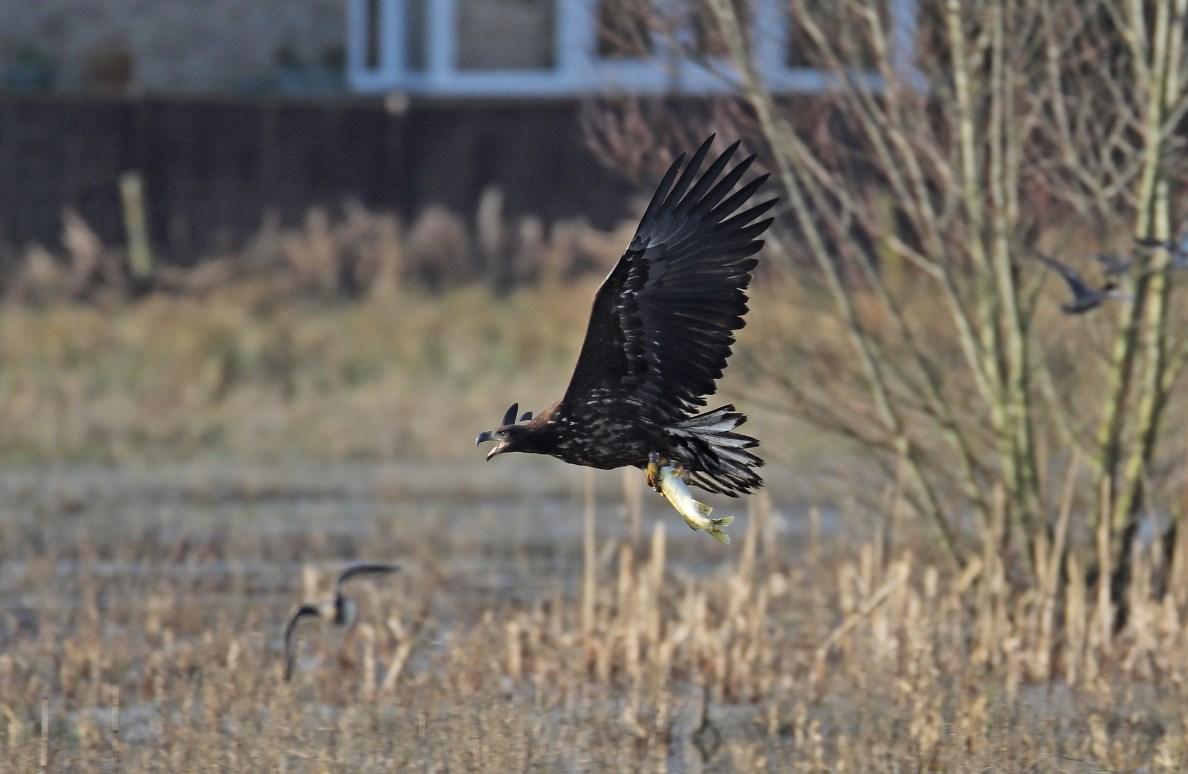
White Admiral 114 21
In our wildlife-friendly garden in Great Waldingfield near Sudbury, amongst other fauna my wife Maria and I have seen Harvest Mouse (Micromys minutus), Field Vole (Microtus agrestis), Bank Vole (Myodes glareolus) and Wood Mouse (Apodemus sylvaticus). We have seen the Harvest Mouse daily, feeding on fat logs put out for the birds. Initially very tame it allowed photographs to be taken, then it was seen holding back as the tits were probably disturbing it, and then noticeably shy.
I placed a nest box nearby with shredded newspaper and soft ornamental grass seed heads inside, next to this a wire mesh platform with fat pellets containing insect, and berry food, dried mealworms, apple, sunflower hearts, seeds and sultanas. This is placed in a dense honeysuckle
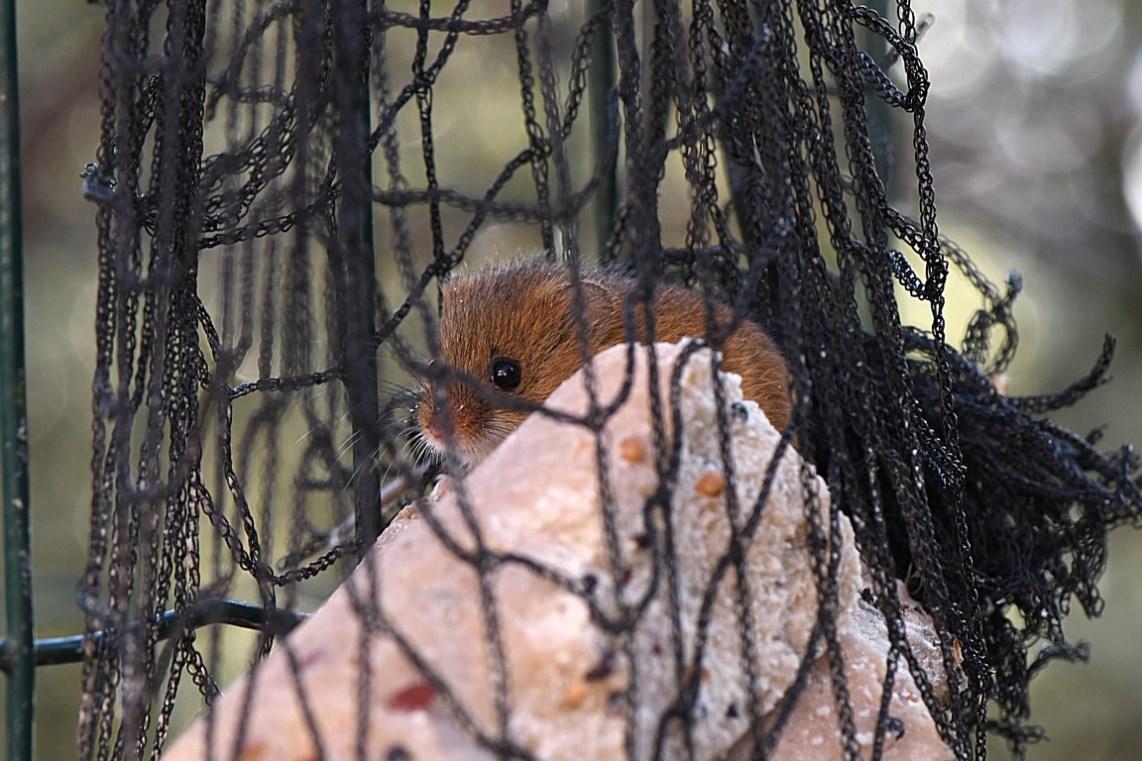
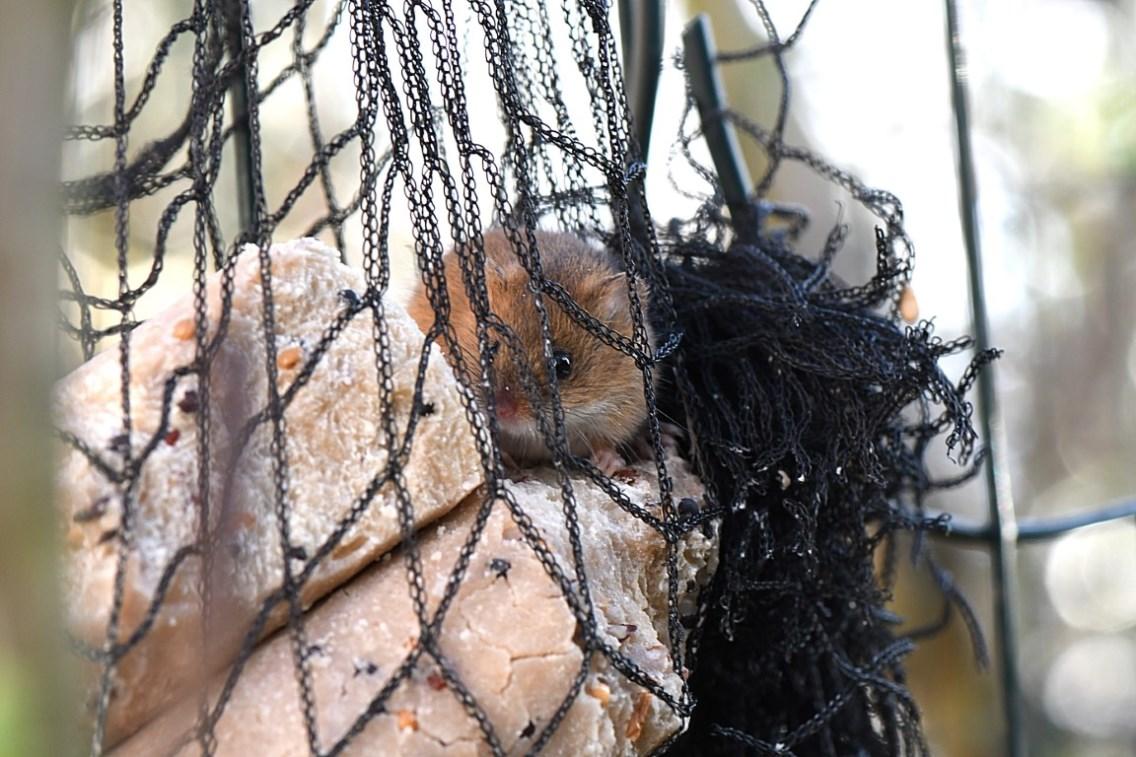
so no birds can access it, it is now a job to see if this mouse is still around. The harvest mouse was seen 6 Jan.24 to the 14 Jan 2024 feeding in the open branches of a spindly leafless shrub. Using its tail around tiny twigs for support, I would guess head and body about 5 cm
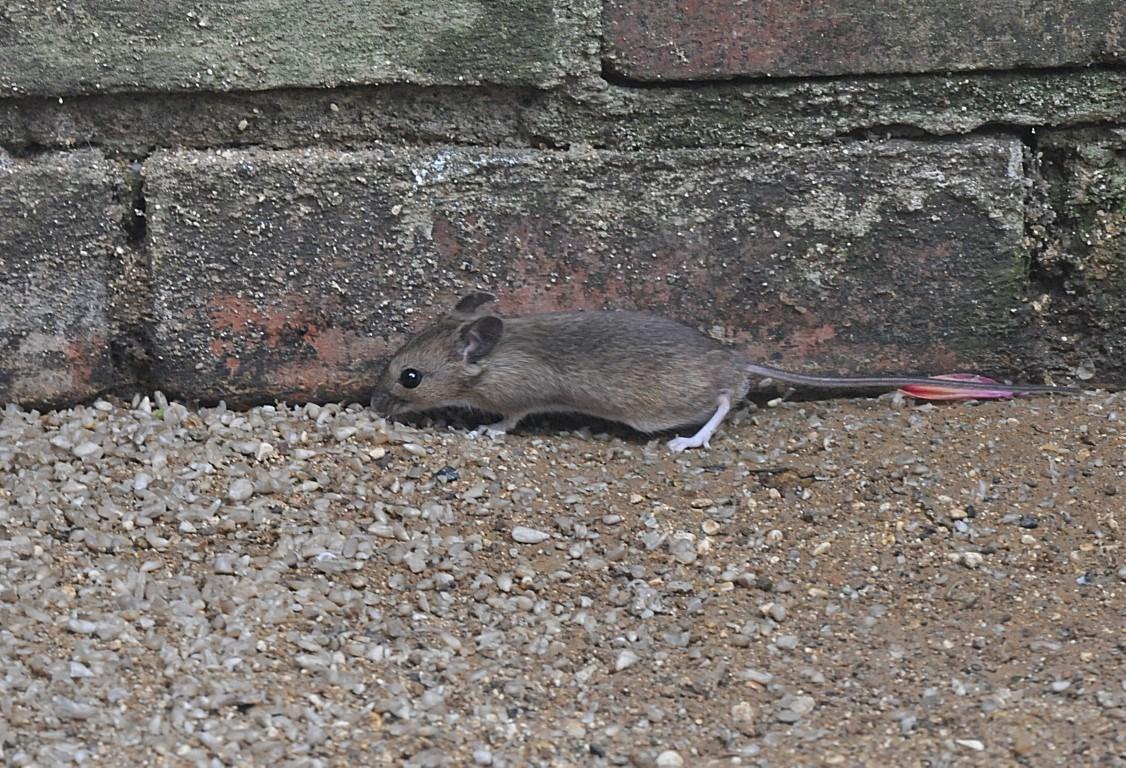
White Admiral 114 22
long, and the tail nearly or about the same length. I am very surprised it found us as we are surrounded by estate type housing almost and nearby hedges and fields don't seem to be the right habitat for it. A wild disused field opposite, is now gone with many houses built on it. Our garden has berry-bearing shrubs, ornamental grasses, and most perennial flowers we grow mainly for wildlife and nectar feeders, two wildlife ponds here doing very well.
The photos illustrate why the Suffolk name is apparently "Red Mouse"! I sent them to the County mammal recorder Alison Looser, who replied

- Great photos, I can definitely confirm it is a harvest mouse. They do occasionally come into gardens and use bird feeders but it is quite rare and they are very rarely seen at all so you are very lucky. They weave their nests into dense grass tussocks so are unlikely to use a nest box, although other species will benefit from that. They are likely to be in the base of the hedgerows, or in the field margins near you if left to grow long. I would be interested to know if you continue to see it.

Previous page top and bottom:
Harvest mouse visiting the suet block.
This page left: Wood mouse
Below: Bank vole
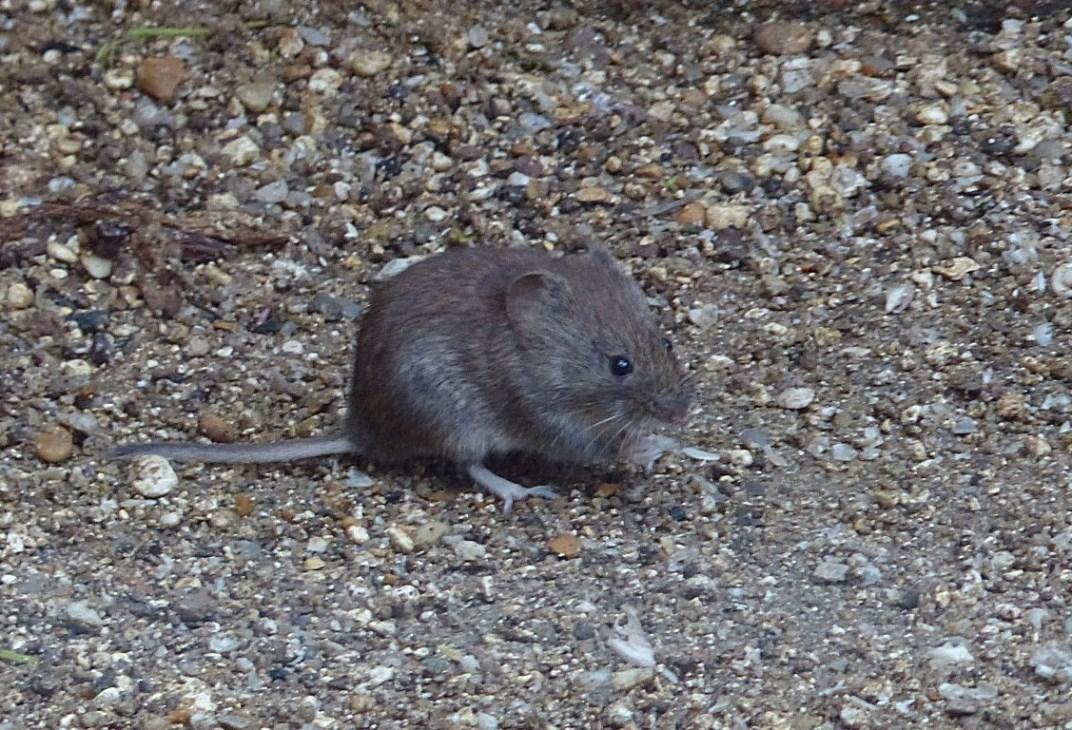
White Admiral 114 23
I have previously written about the diverse range of species choosing one of our veteran Oak trees, but this time I thought readers might be interested how attractive our cart lodge is to wildlife too.
I have erected many nest boxes over the years so there is plenty for birds and bats to choose from. Two owl boxes are occasionally used by a male Barn Owl to roost but mainly Stock Doves insist on nesting in both. The evidence that the Barn Owl has been, is obvious by the white splashes and occasional pellet on the floor (photo).
An old Parrot’s nest box I bought for a quid at a boot sale sitting on a pile of bricks is again occupied by Great Tits and a Blue Tit box with a hole enlarged by Woodpeckers and Squirrels has suited a Robin this year.
ClosebyaWren has built anest on a beam by using TV aerial cable for support.
Pied Wagtails nest in the ridge of the roof annually and during nestbuilding cause a lot of mess as they seem unbothered that most of their nesting material falls through a gap on to the floor. This is not normally retrieved.
Various bat boxes seem to be more attractive to Blue Tits to roost in rather than Bats, in fact I have seen a Bat go to roost in a gap behind the bat box!
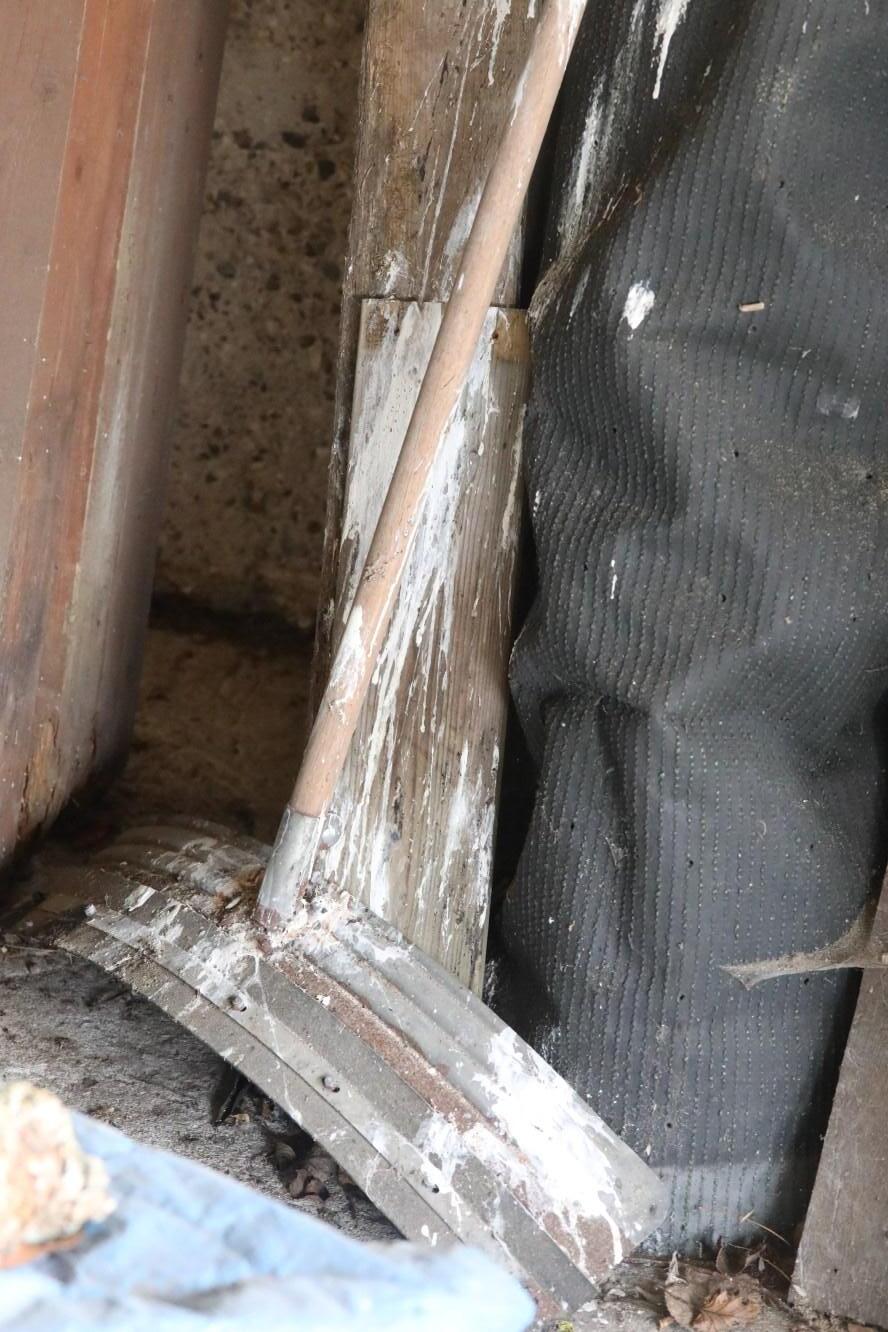
White Admiral 114 24
Wood piles are sometimes adopted by Peacock butterflies for hibernation and the firewood that sits for more than a year often supports various wood boring beetles and Bees and Wasps.
I also have a few Bee hotels made from bamboo and wood blocks drilled with holes of varying sizes. These become very busy and sometimes filled to capacity with various resin, mason and leaf-cutter bees. This concentration of bee activity attracts Ichneumons that probe for larvae to parasitize in any gaps in the hotels or the barn’s wooden structure.
I have tried to encourage Swallows to nest in the roof by constructing shelves and even an open box with ledges for them, but the early summer exploratory birds don’t seem to fancy the idea. At the end of the summer, the young Swallows rest in the roof joists to be fed by their parents as they prepare for migration.
My front door is in the cart lodge, and to my cat’s amusement, Blue Tits and Great Tits happily tug hairs and fibres from the door mat immediately in front of the cat flap as ‘Ziggy’ watches from the inside inches away.
Please see page 28 for full details and agenda.
White Admiral 114 25
95thAGM & Spring Member’s Evening. 24th April, 7-10pm John Peel Centre, Church Walk, Stowmarket, IP14 1ET
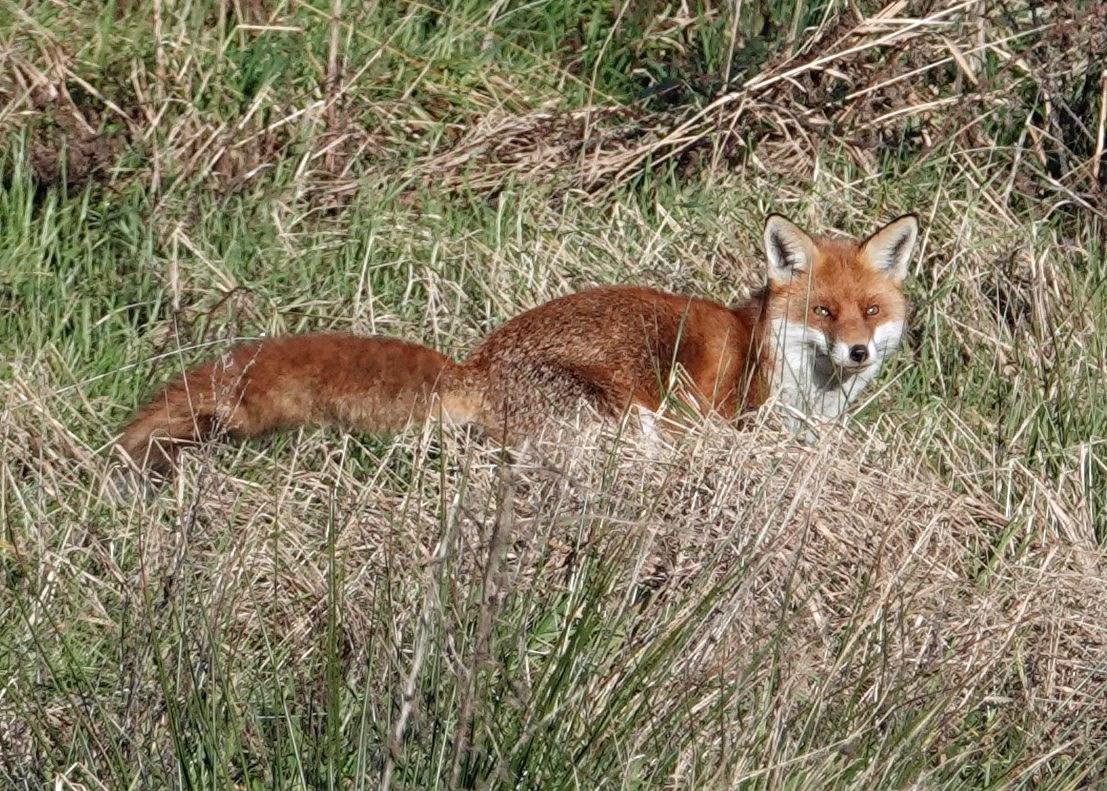


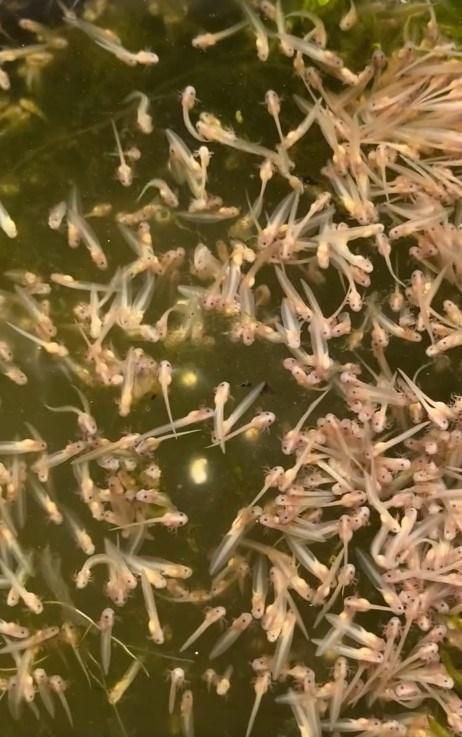
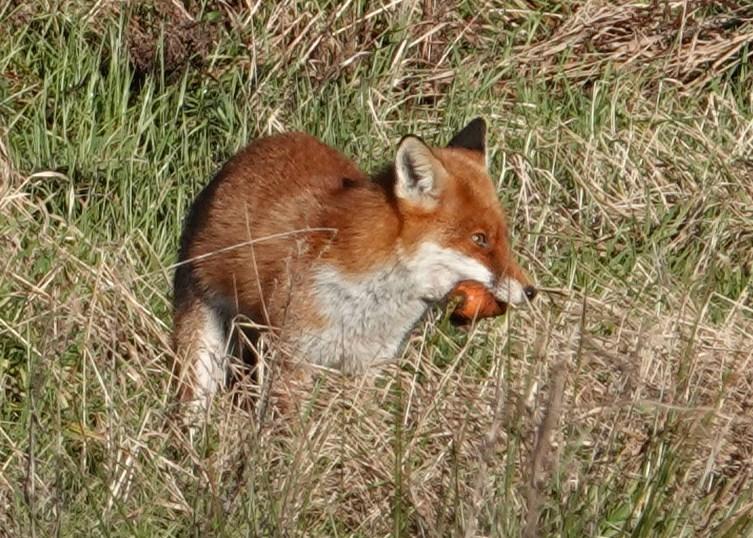
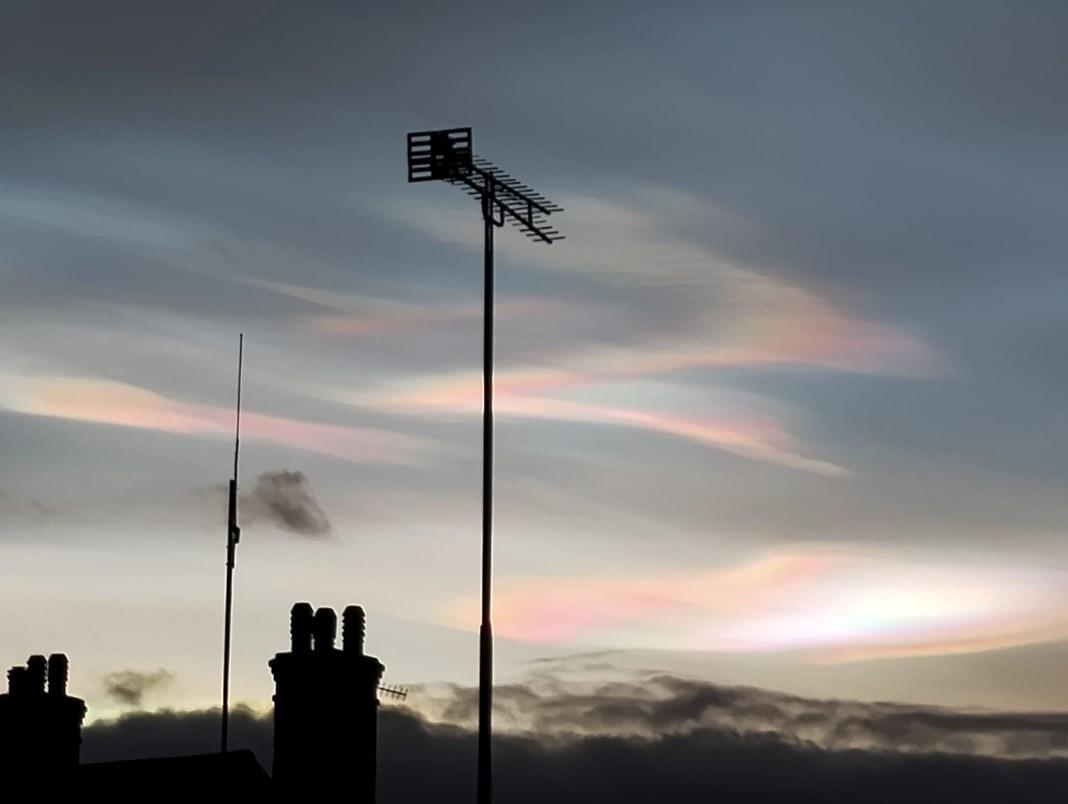
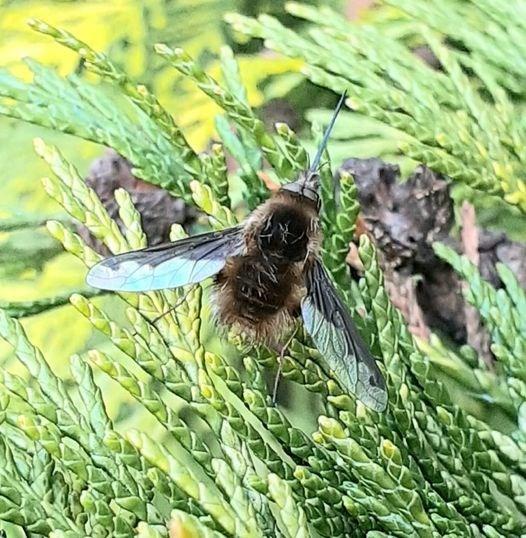
White Admiral 114
Left top and below: Vegetarian fox with carrot by Stewart Belfield.
Bottom left: Spotted Redshank in Martlesham Creek by Stewart Belfield.
Bottom right: Nacreous clouds photographed by Dot Richards.



Top left: Albino frogspawn for 2 years running in Stewart Belfield’s pond in Bredfield.
Top right: Buff-tailed bumblebee on willow by Paul Gilson.

Bottom right:
Bottom

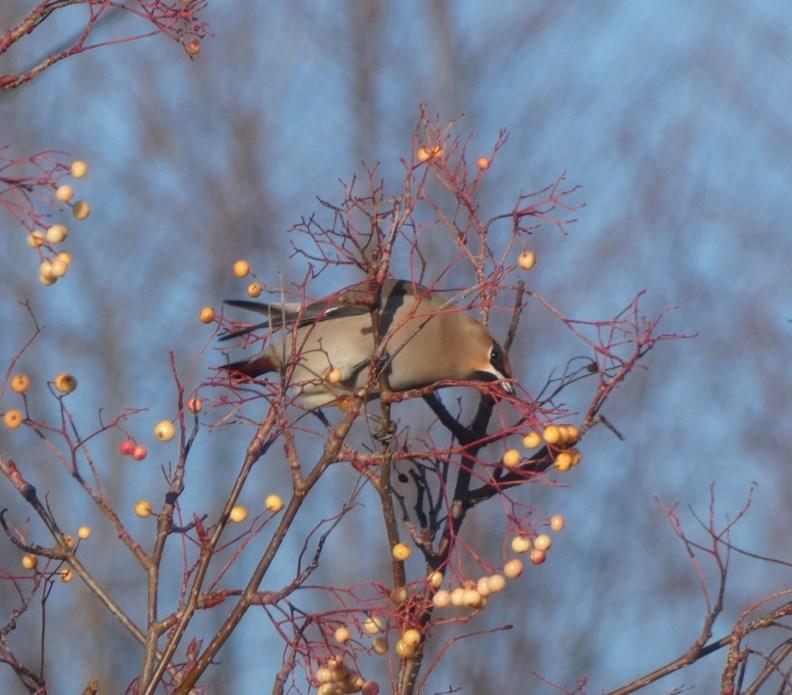
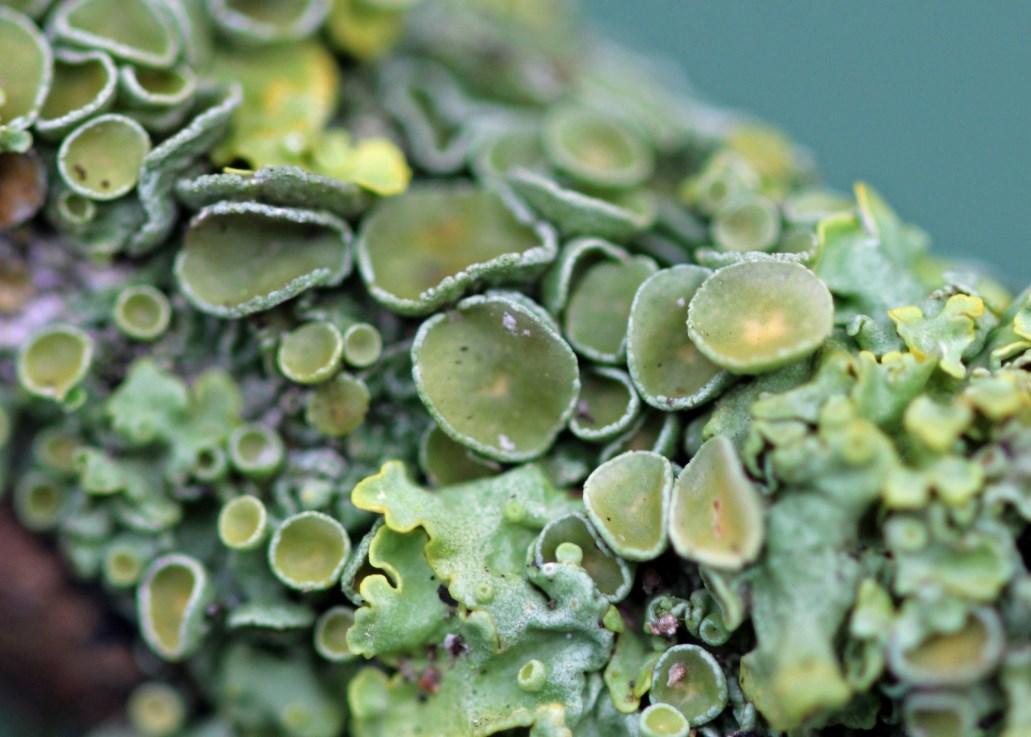
There have been so many amazing photos on our Facebook page that there’s not enough room to show here. Please keep sharing though and importantly of all, keep recording those sightings.
White Admiral 114 27
Right: Waxwing by Paul Gilson.
Common Orange Cup lichen by Stewart Belfield.
left: Dark-edged Beefly by Bill Davis
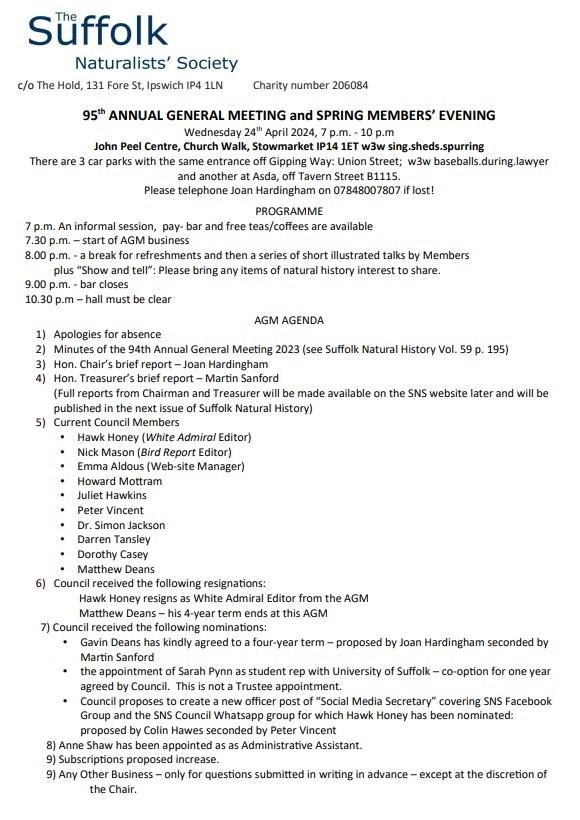
White Admiral 114 28







